Libraries have evolved far beyond being simple repositories of books, becoming architectural statements that celebrate knowledge, culture, and human creativity through stunning design. These extraordinary buildings demonstrate how thoughtful architecture can inspire learning, foster community, and create spaces where the pursuit of knowledge becomes an aesthetic experience as profound as the information contained within their walls.
Here is a list of 20 libraries that are architectural masterpieces, each combining functional excellence with breathtaking design.
Trinity College Library

Dublin’s Long Room stretches 213 feet through the Old Library, featuring a barrel-vaulted ceiling supported by elegant columns that create one of the world’s most photographed library interiors. The library houses over 200,000 rare books, including the Book of Kells, within wooden shelves that tower 30 feet high and require ladders for access.
Built in 1732, this architectural marvel inspired the Jedi Archives in Star Wars and remains a testament to the pinnacle of classical library design, with its perfect proportions and timeless elegance.
Beinecke Rare Book Library
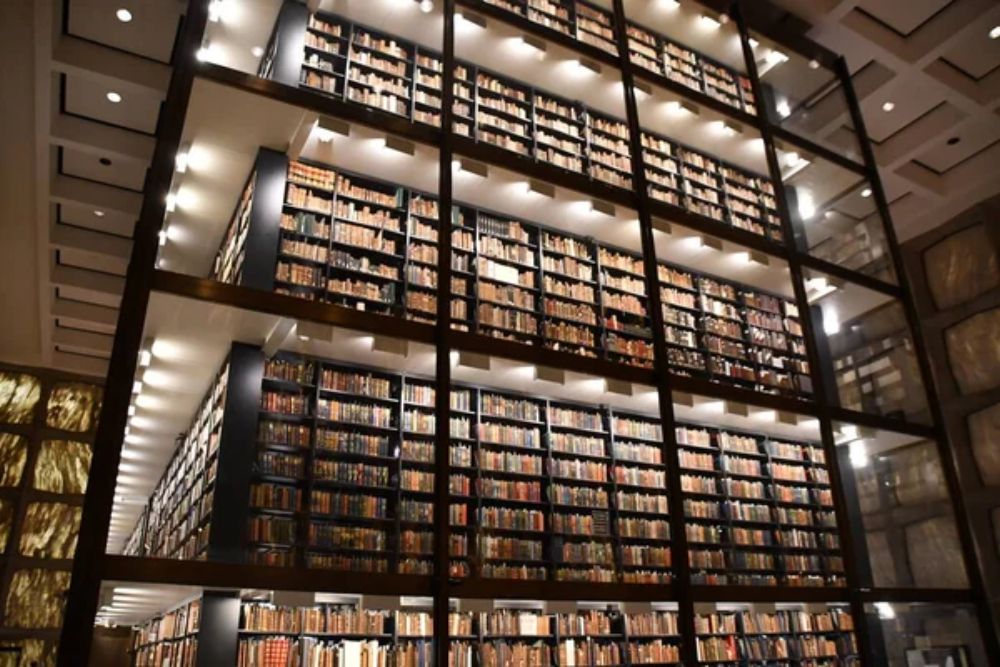
Yale University’s translucent marble walls filter natural light to protect rare manuscripts while creating an ethereal glowing effect that transforms the building into a giant lantern. The windowless design uses Vermont marble panels thin enough to be translucent, allowing daylight to illuminate the interior without harmful ultraviolet rays that might damage the collection.
This modernist masterpiece houses one of the world’s largest collections of rare books and manuscripts within a climate-controlled environment that appears to float above ground level.
Like Travel Pug’s content? Follow us on MSN.
Biblioteca Vasconcelos
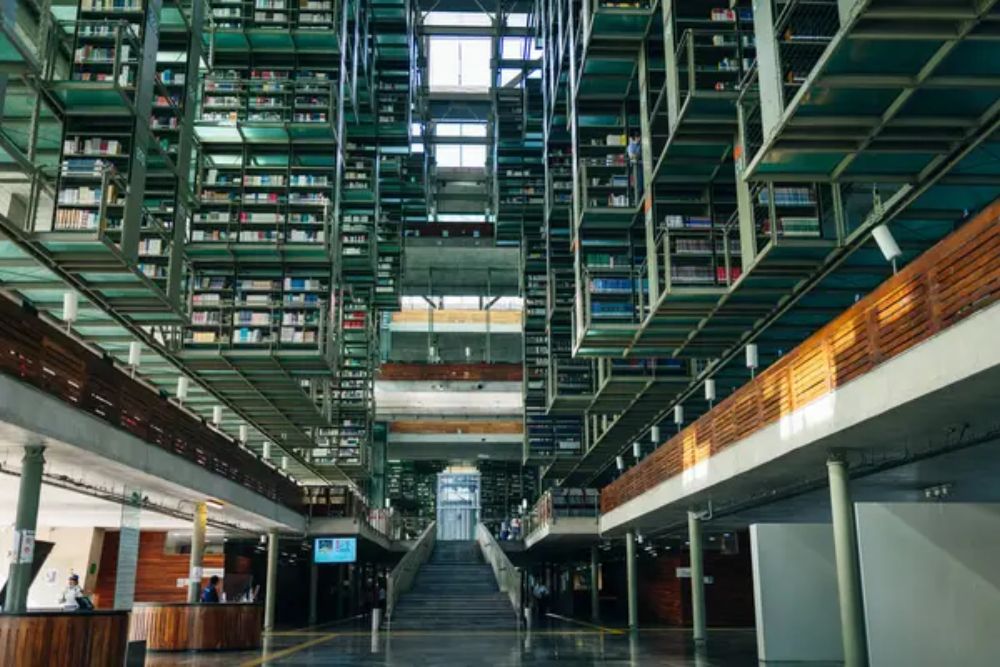
Mexico City’s massive glass and steel structure stretches over 400,000 square feet, featuring a transparent design that allows visitors to see the entire collection from any point within the building. The library’s open-plan architecture eliminates traditional walls between sections, creating flowing spaces connected by floating walkways and suspended reading areas.
This contemporary masterpiece serves over 2 million visitors annually while demonstrating how modern library design can create democratic access to information through transparent, barrier-free architecture.
Library of Alexandria
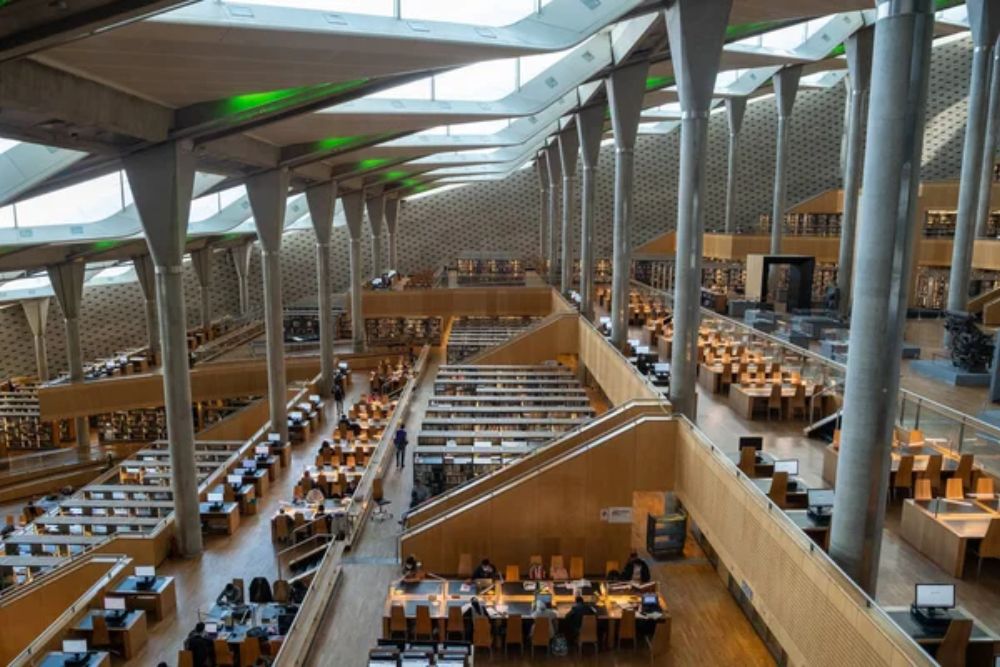
Egypt’s modern interpretation of the ancient world’s greatest library features a distinctive circular design with a tilted roof that resembles a rising sun over the Mediterranean. The building’s granite exterior displays characters from 120 different scripts, representing the diversity of human knowledge and writing systems throughout history.
This 21st-century architectural achievement combines cutting-edge technology with symbolic design elements that honor the original library’s role as humanity’s first great center of learning and scholarship.
Seattle Central Library
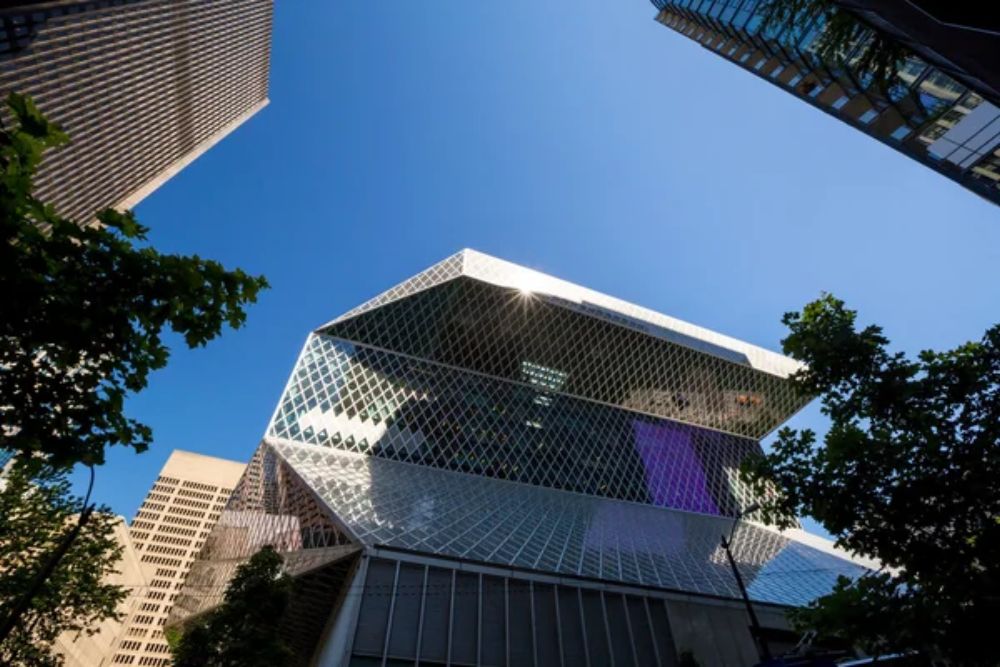
Rem Koolhaas designed this angular glass and steel structure that defies conventional library architecture through its bold geometric form and innovative spatial organization. The building’s faceted exterior creates irregular interior spaces that challenge traditional library layouts while maximizing natural light and city views.
This architectural landmark demonstrates how contemporary design can revolutionize library functionality, featuring automated book-sorting systems, flexible meeting spaces, and technology integration that transforms the way people interact with information.
Like Travel Pug’s content? Follow us on MSN.
Admont Abbey Library
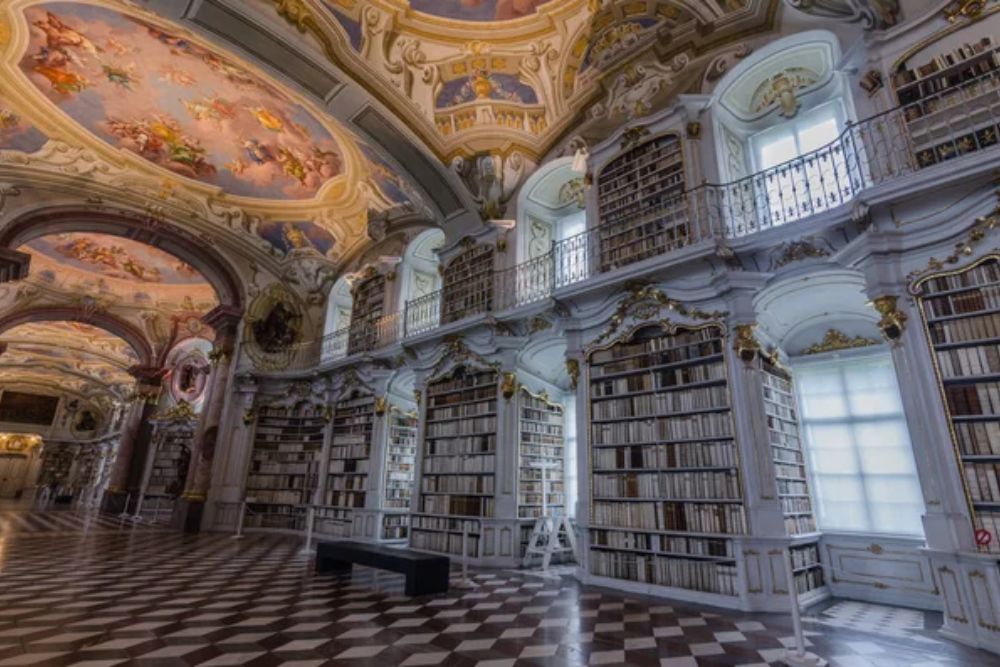
Austria’s baroque masterpiece features the world’s largest monastic library hall, adorned with elaborate frescoes, gold leaf decorations, and carved wooden sculptures that create a heavenly atmosphere for scholarly pursuits. The library’s ceiling frescoes depict the stages of human knowledge from divine revelation to enlightenment. At the same time, white and gold baroque details create an ornate setting that elevates reading to a spiritual experience.
This 18th-century architectural marvel showcases how religious architecture can create inspiring environments for intellectual and spiritual growth.
Geisel Library
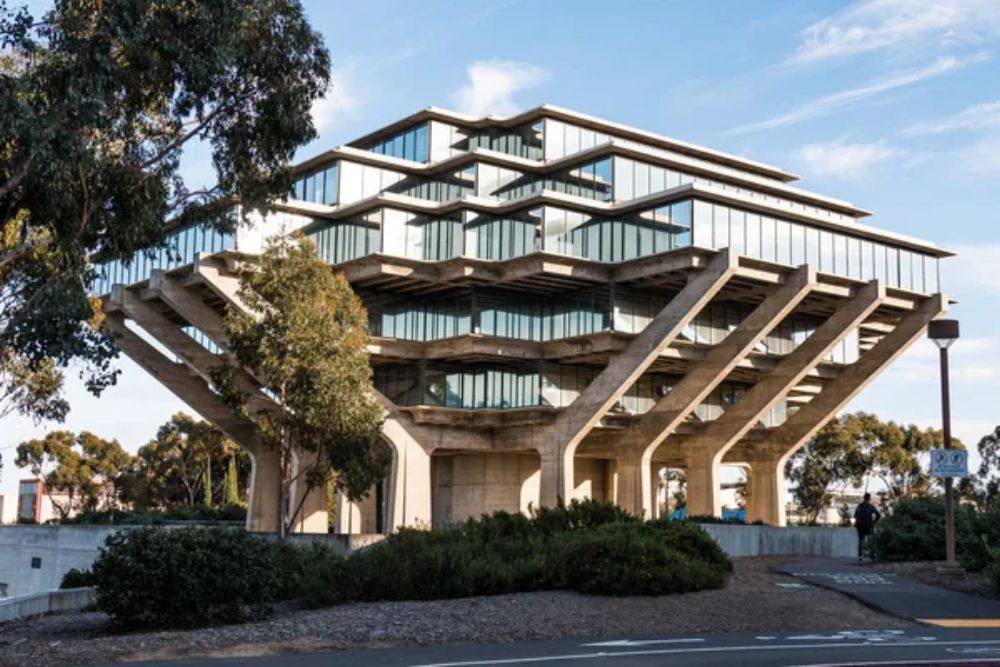
University of California, San Diego’s brutalist concrete structure resembles a spaceship or tree trunk, with its distinctive cantilevered design that creates dramatic interior spaces flooded with natural light. The building’s unique form eliminates the need for interior columns on most floors, creating open, flexible spaces that can adapt to changing technology and learning methods.
This architectural icon of the 1970s proves that bold, unconventional design can create functional beauty that inspires students and faculty for generations.
Strahov Monastery Library
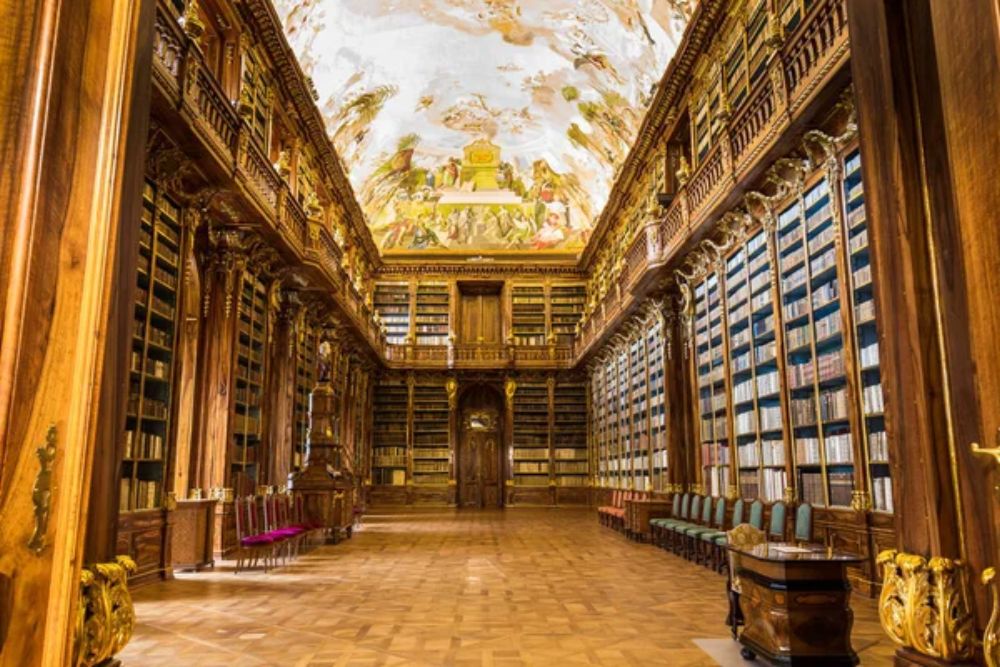
Prague’s Baroque library complex features two magnificent halls decorated with elaborate frescoes, antique globes, and thousands of ancient volumes, creating an atmosphere of scholarly grandeur. The Theological and Philosophical halls showcase different periods of baroque decoration while housing collections that span centuries of European intellectual history.
These architectural masterpieces demonstrate how monastic libraries preserved knowledge during turbulent historical periods, creating spaces that inspire reverence for learning and wisdom.
Like Travel Pug’s content? Follow us on MSN.
Stuttgart City Library
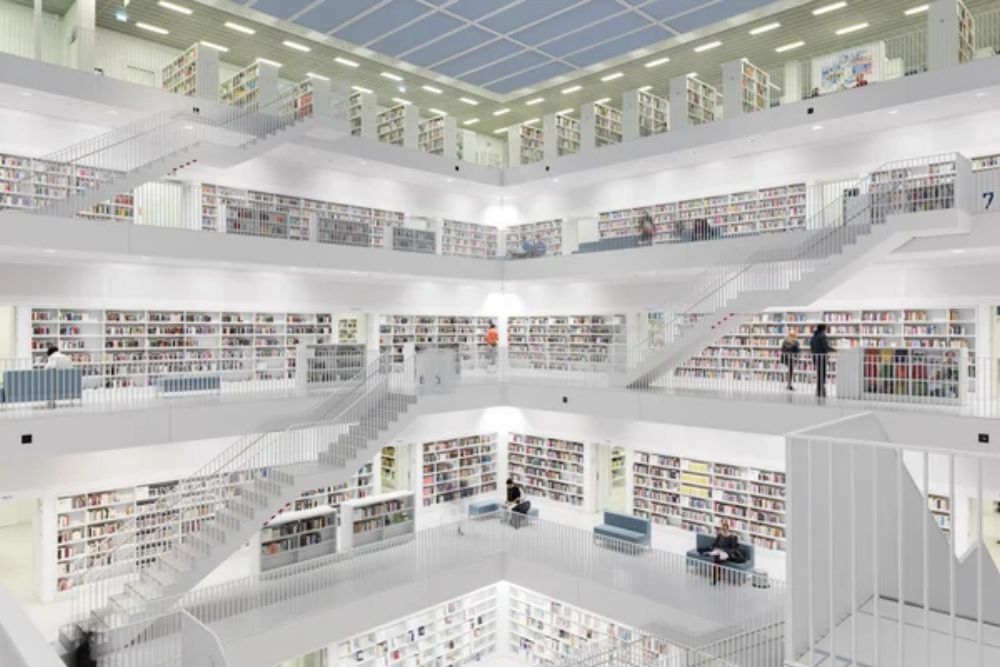
This minimalist cube features stark white interiors that create a meditative atmosphere for reading and contemplation, with natural light filtering through carefully placed openings. The building’s simple geometric form conceals complex interior spaces organized around a central void that draws visitors upward through multiple levels.
This contemporary masterpiece demonstrates how restrained architectural design can create powerful emotional responses while providing flexible spaces for 21st-century library services.
Biblioteca Parque España
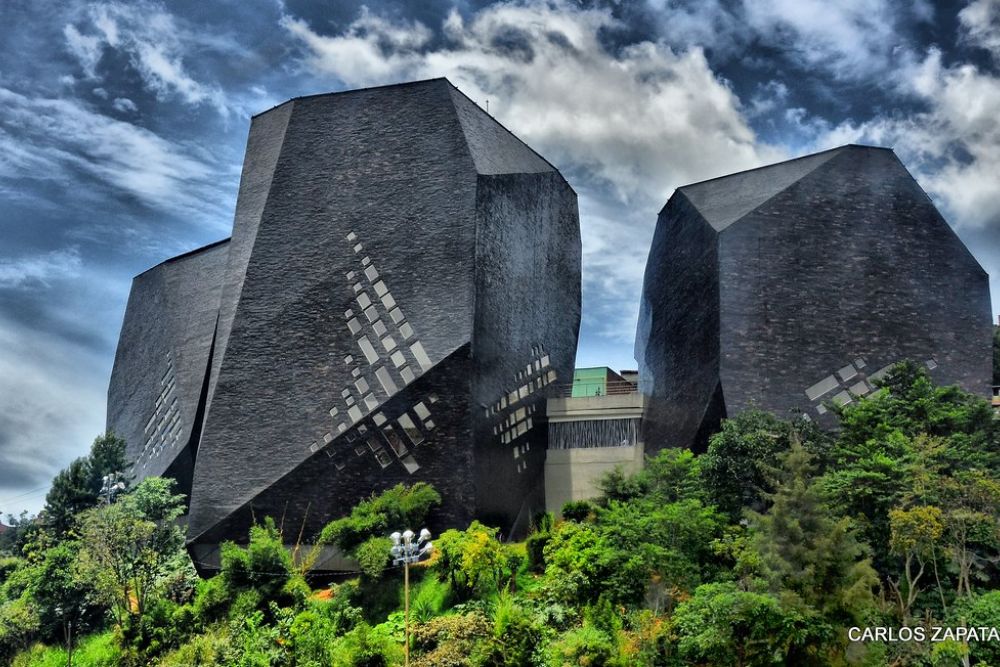
Colombia’s innovative library in Medellín features three interconnected buildings that resemble giant black rocks scattered across a hillside in one of the city’s most challenged neighborhoods. The dramatic architecture serves as a symbol of urban renewal and educational opportunity, providing world-class facilities in areas previously lacking adequate public services.
This architectural intervention demonstrates how bold library design can catalyze community transformation while creating inspiring spaces for learning and cultural activities.
Real Gabinete Português de Leitura
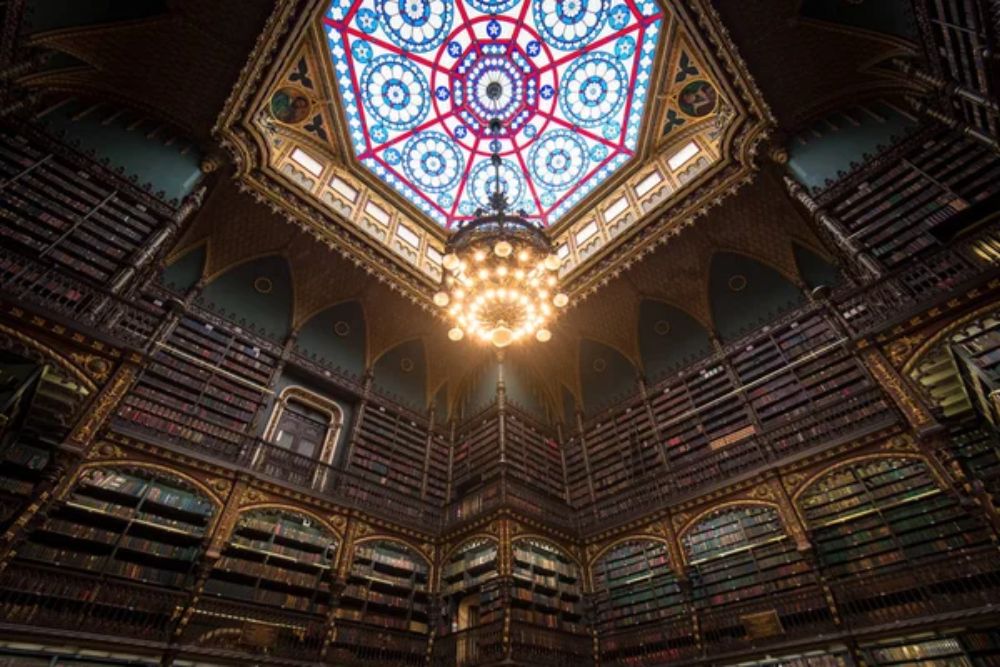
Rio de Janeiro’s Portuguese Reading Room features a soaring Gothic Revival interior with carved wooden details, stained-glass windows, and spiral columns that create a cathedral-like atmosphere for reading. The library boasts the largest collection of Portuguese literature outside Portugal, housed within an architectural setting that celebrates Portuguese cultural heritage in Brazil.
This 19th-century masterpiece demonstrates how immigrant communities can create architectural monuments that preserve cultural identity while contributing to their new homeland’s cultural landscape.
Like Travel Pug’s content? Follow us on MSN.
Phillips Exeter Academy Library
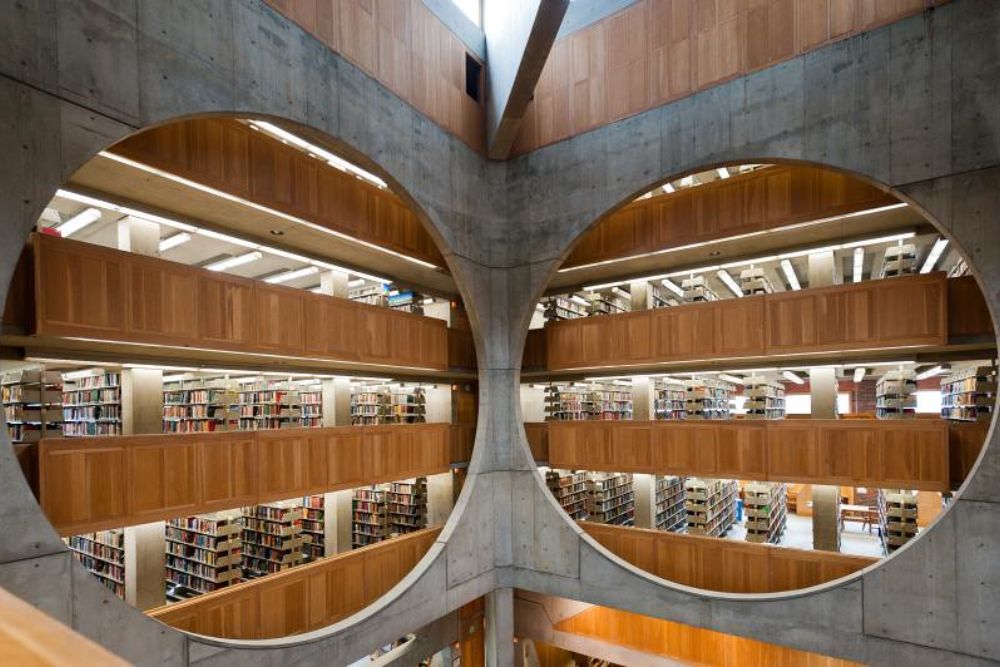
Louis Kahn’s modernist masterpiece features a central atrium surrounded by reading carrels that create intimate study spaces within a grand architectural framework. The building’s brick exterior and carefully orchestrated natural lighting create warm, human-scaled spaces that encourage contemplation and learning.
This architectural achievement demonstrates how modernist principles can create emotionally resonant spaces that support the educational mission while inspiring students through beautiful, functional design.
Biblioteca José Vasconcelos
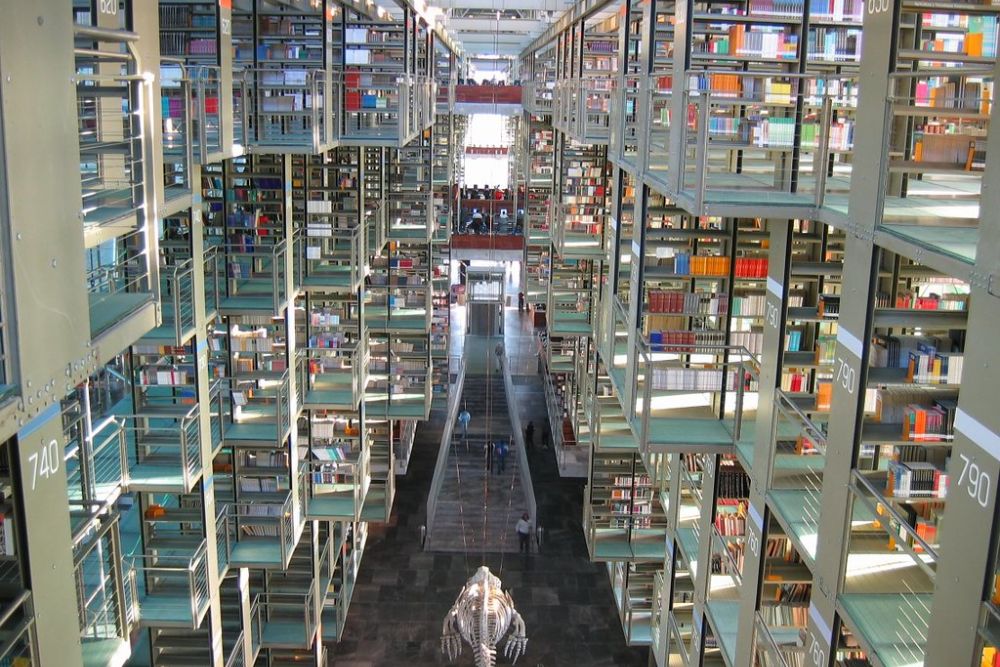
Mexico’s national library boasts a transparent design that eliminates walls between its various sections, creating a democratic space where all knowledge appears equally accessible to visitors. The building’s glass exterior and open interior organization reflect Mexico’s commitment to educational equality and cultural openness.
This contemporary architectural statement demonstrates how library design can embody political and social values while creating functional spaces for modern information access and community gathering.
Tama Art University Library
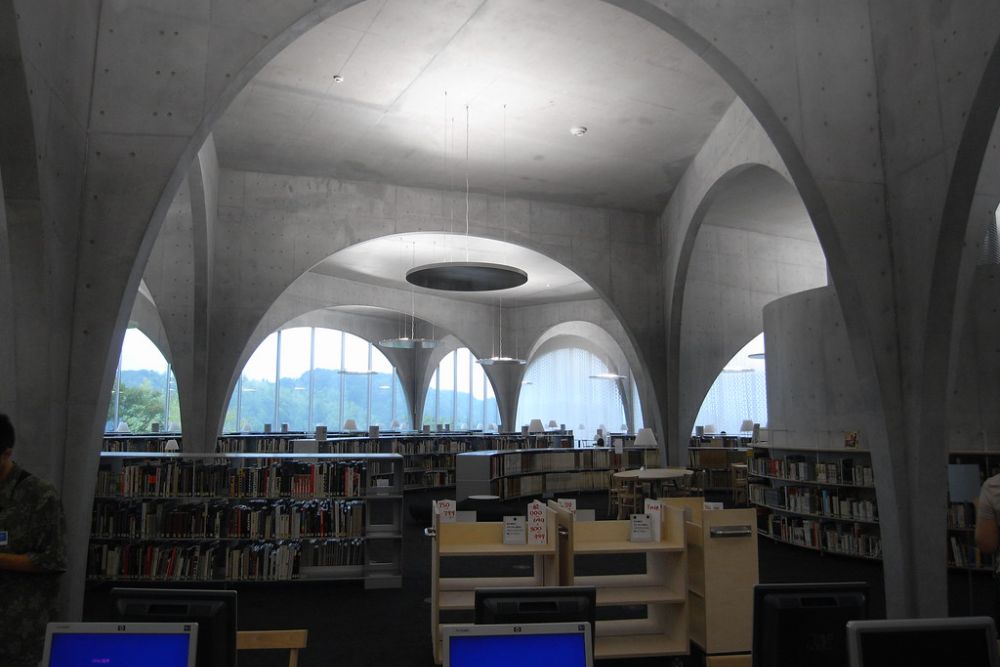
Tokyo’s concrete and glass structures create dramatic interior spaces through their bold geometric forms and carefully controlled natural lighting, which transforms throughout the day. The building’s unique architectural character inspires creativity while providing functional spaces for art education and research.
This contemporary masterpiece showcases how university libraries can serve as architectural expressions of their institution’s educational mission, while creating inspiring environments that foster student creativity and learning.
Like Travel Pug’s content? Follow us on MSN.
Biblioteca Central
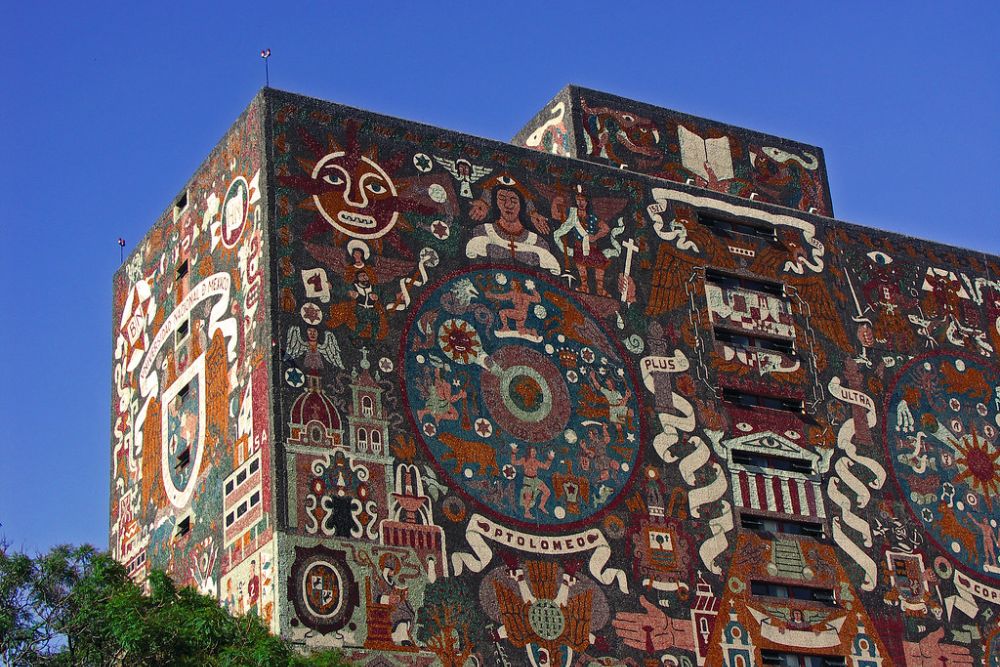
Mexico City’s University Library features a windowless cube covered in colorful stone mosaics created by artist Juan O’Gorman that depict Mexico’s cultural history. The building’s unique facade transforms the library into a massive public artwork while the interior provides climate-controlled storage for millions of volumes.
This mid-century architectural achievement showcases how libraries can become cultural landmarks that celebrate national identity while serving as educational hubs for university communities.
National Library of China
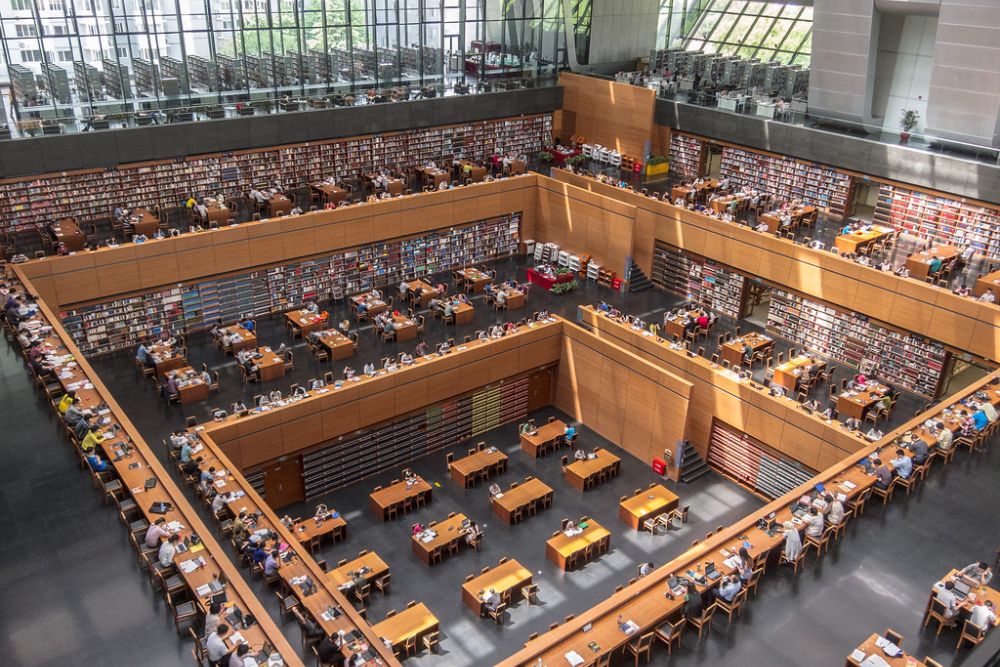
Beijing’s massive complex combines traditional Chinese architectural elements with contemporary design, creating spaces that honor Chinese cultural heritage while serving modern information needs. The building’s scale and grandeur reflect China’s commitment to education and cultural preservation while accommodating millions of visitors annually.
This architectural achievement showcases how contemporary library design can seamlessly integrate traditional cultural elements with world-class facilities for research and public access to information.
Library of Birmingham
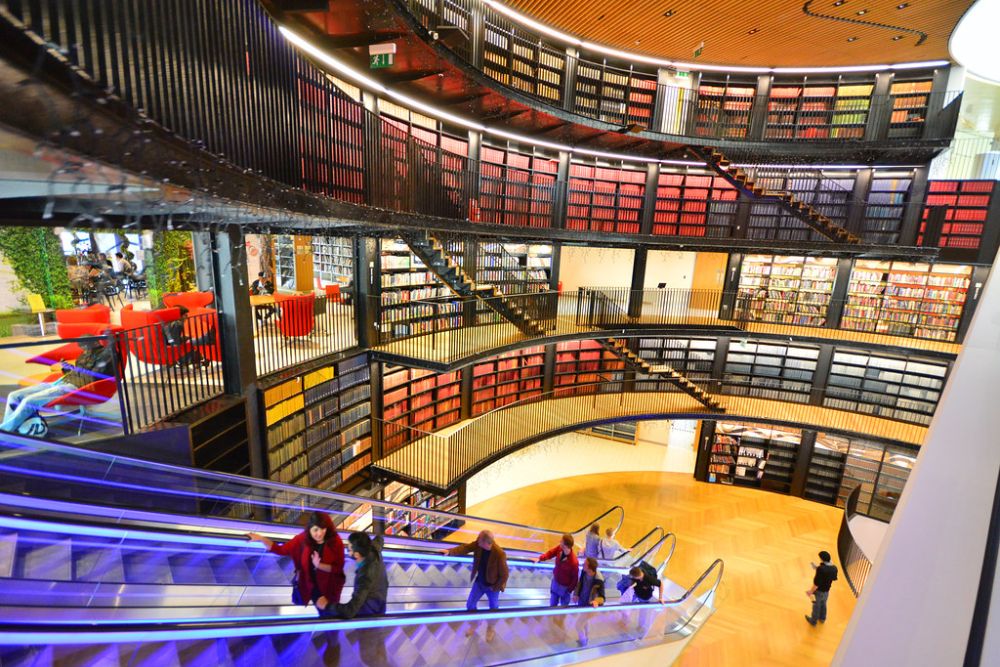
This contemporary cube features intricate metalwork facades inspired by traditional Islamic patterns, creating a building that celebrates the city’s multicultural heritage while providing state-of-the-art library services. The building’s multiple levels and flexible spaces accommodate a range of uses, from rare book collections to community meeting rooms and performance venues.
This architectural landmark exemplifies how public libraries can serve as symbols of urban renewal, creating inclusive spaces that cater to diverse community needs.
Like Travel Pug’s content? Follow us on MSN.
Musashino Art University Library
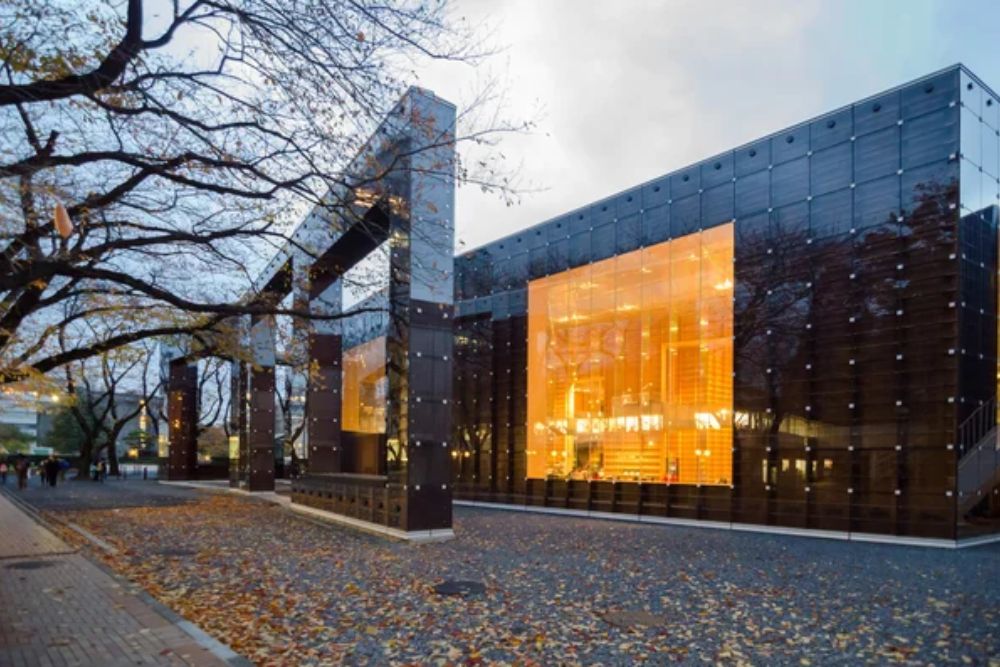
Tokyo’s curved building resembles a massive bookshelf wrapped around reading spaces, with its distinctive facade created by thousands of small openings that filter natural light while maintaining privacy. The interior features spiraling spaces that encourage exploration and discovery while providing quiet areas for focused study.
This contemporary masterpiece demonstrates how architectural creativity can enhance library function while creating visually striking buildings that inspire users and passersby.
George Peabody Library
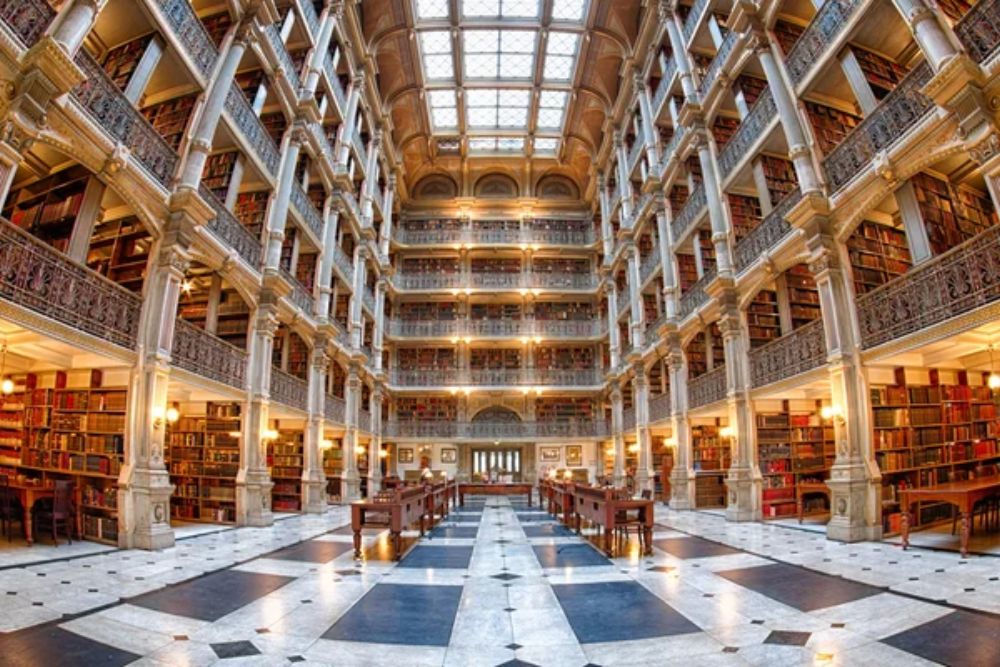
Baltimore’s Cathedral of Books features five tiers of ornate cast-iron balconies that reach 61 feet high, creating a breathtaking interior space that celebrates the beauty of books and the joy of reading. The library’s Neo-Grecian architecture and soaring proportions transform book storage into an almost religious experience for visitors.
This 19th-century architectural achievement showcases how library design can enhance the act of reading while creating public spaces that foster civic pride and intellectual curiosity.
Vennesla Library and Culture House
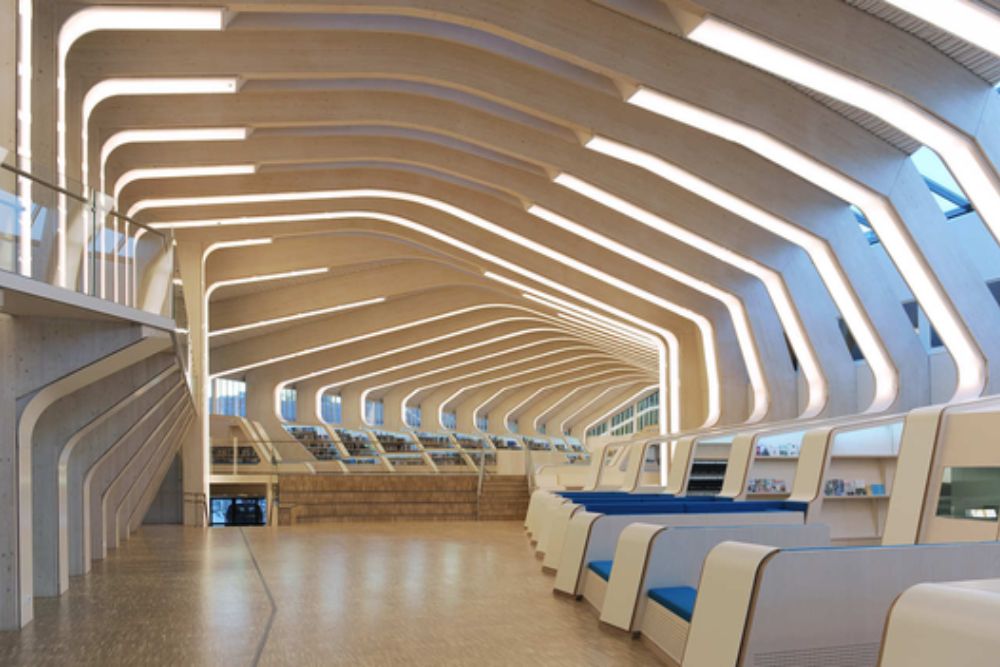
Norway’s distinctive structure features curved wooden ribs that create a flowing interior landscape while providing acoustic control and natural lighting for reading areas. The building’s organic form contrasts with traditional library architecture, creating warm and inviting spaces that encourage community use.
This contemporary masterpiece showcases how innovative architectural approaches can transform library design, creating environmentally sustainable buildings that serve multiple community functions.
Like Travel Pug’s content? Follow us on MSN.
Where Knowledge Takes Form
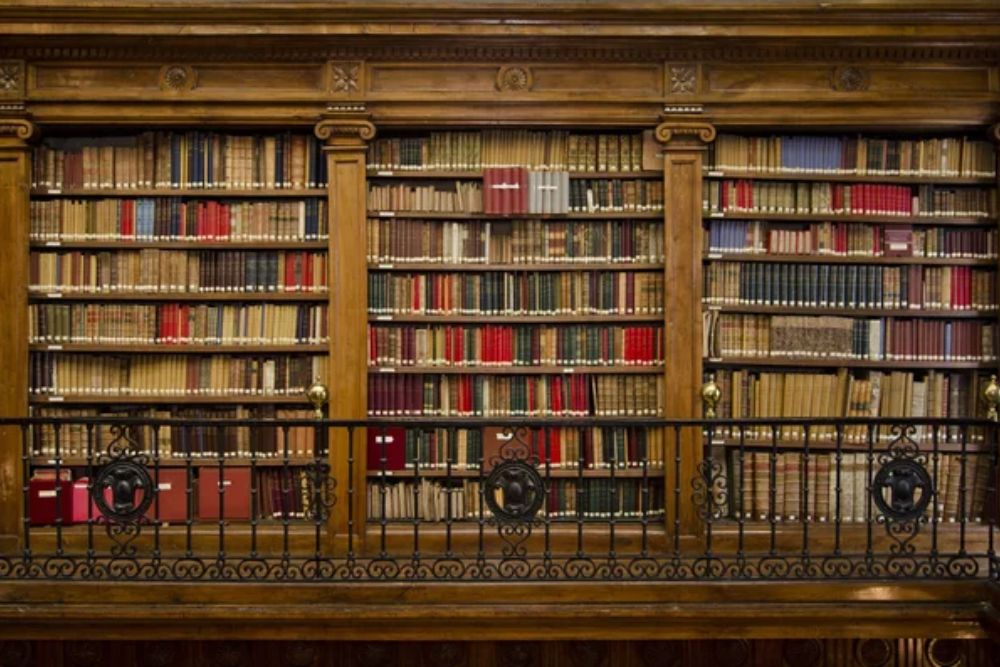
These extraordinary libraries prove that architecture can transform the simple act of reading into profound cultural experiences that inspire, educate, and uplift human spirits. From baroque grandeur to minimalist contemporary design, each building demonstrates how thoughtful architecture can enhance learning while creating spaces that become cultural landmarks for their communities.
The diversity of architectural approaches shows that there is no single way to create inspiring library spaces, but rather multiple paths to achieving the perfect marriage of function and beauty. These masterpieces remind us that libraries are more than repositories of information—they are temples of human knowledge where architecture and learning combine to create some of civilization’s most meaningful and beautiful spaces.
More from Travel Pug

- 20 Best Beach Towns in the Carolinas
- 13 Destinations Where Tourists Regularly Regret Their Trip
- 20 Destinations That Are More Magical Without an Itinerary
- 20 Underrated Adventures That Belong on Your Travel List
- 20 Cities Where You Should Just Wing It, No Planning Required
Like Travel Pug’s content? Follow us on MSN.
